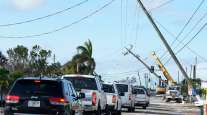Senior Reporter
COVID-19 Vaccine Key to Restoring Economic Stability, Experts Say

[Ensure you have all the info you need in these unprecedented times. Subscribe now.]
The incoming Biden administration faces a U.S. economy that appears to be slowing as COVID-19 cases surge.
Vaccinations in the U.S. began Dec. 14, and so far, 9.94 million doses have been given, according to a state-by-state tally by Bloomberg News and data from the Centers for Disease Control and Prevention updated Jan. 12. An estimated 36% of the 27.7 million doses distributed have been administered.
But experts say the economy may be poised for a more robust rebound later in 2021 if the vaccination process proves successful and the new Congress and team in the White House can agree on a third stimulus bill.

Costello
“We’re slowing down from the pace of growth in the third quarter,” ATA Chief Economist Bob Costello told Transport Topics. “I really think with the stimulus that was done in December, and the prospects of more stimulus, I do believe the economy is going to grow at a better clip than I thought even a month ago.”
The Bureau of Economic Analysis said that in the third quarter of 2020, the gross domestic product rose 33.1%, after falling 31.4% in the second quarter. Costello said as the pace of the vaccination process increases, it is possible GDP growth could hit 4% or higher in the second half of the year as the economy gradually normalizes.
Costello said the trucking industry continues to perform at a high level, restocking grocery stores, distributing the vaccine and personal protective equipment, and there’s been a surge of single-family home building, which is keeping fleets busy.

Burks
Economist Stephen Burks at the University of Minnesota-Morris told TT consumer consumption patterns had changed rapidly and that the trucking industry has been able to keep up with the abrupt shift in cargo.
“Because the mixture of final demand has changed, that has worked backward up the supply chain to make the mixture of freight to be changed,” Burks said. “Trucking companies that were serving grocery stores saw their business skyrocket, but if you’re a tanker company transporting gas, your business fell.”
RELATED: Trucking Industry Economy Outpaces US Economy as Capacity Tightens
The December 2020 Logistics Managers’ Index Report showed that trucking finished the year strong with a 66.7 rating, compared with 54.0 in the same month in 2019.
However, December is down 5.7% when measured against November’s 70.8. It marked the first time since September the index has been below 70.

Rogers
Arizona State University business professor Dale Rogers, one of the index’s authors, said the rapid growth of e-commerce fueled December’s healthy number.
“December capped a period of record package delivery. Overall volume was up 30%, with Amazon alone delivering 1.5 billion items during the holiday season,” Rogers said. “The strain on logistics networks caused by this increased volume is epitomized in USPS, which handled approximately 6 million packages a day and watched its on-time delivery rates of first-class mail dropping from 95% in December 2019 to 75% in 2020. UPS and FedEx maintained higher levels of service but were likely helped in this endeavor by placing package caps on multiple shippers to limit volume.”
Rogers said the high volume of imports coming into U.S. ports likely will continue for several months in 2021.
“2020, fourth-quarter shipments into the Port of Los Angeles were up 28.2% from 2019 with up to 20 ships waiting in line to unload goods on some days in December,” he said. “The unknown factor in this demand is vaccine distribution, which is predicted to ramp up during the first and second quarter.”
The National Retail Federation on Jan. 8 said its monthly Global Port Tracker showed the nation’s ports handled 2.11 million 20-foot-equivalent units (TEUs) in November. That’s up 24.5% year-over-year.
“Consumers and retailers once again proved their resilience in the face of unprecedented challenges,” NRF Vice President Jonathan Gold said. “Thanks in part to government stimulus, retail sales saw strong growth during 2020 even with the pandemic, and import numbers show retailers expect the economic recovery will continue during 2021.”
The Mastercard SpendingPulse report said overall retail sales were up 3% over the extended holiday shopping season, which started several weeks earlier because of the pandemic. Holiday e-commerce sales made up 19.7% of total retail sales in October, November and December, compared with 13.4% in 2019.

Dhawan
Economist Rajeev Dhawan, director of the Economic Forecasting Center at Georgia State University, told TT the incoming administration will need to move quickly to accelerate the vaccine’s distribution before the economy will see any long-lasting improvement.
“If you could give everyone the vaccine in the next month and everyone takes it, you would have a great 2021, but that’s not going to happen,” Dhawan said. “The virus dictates the economic recovery, whether it’s going to be good or bad.
“The idea that you can counter the virus with a stimulus is wrong; it’s just a sugar high. It can just stop the bleeding. We have to get enough vaccinated so enough people feel comfortable being in social settings. That’s the key to getting back to normal.”
Want more news? Listen to today's daily briefing:
Subscribe: Apple Podcasts | Spotify | Amazon Alexa | Google Assistant | More




